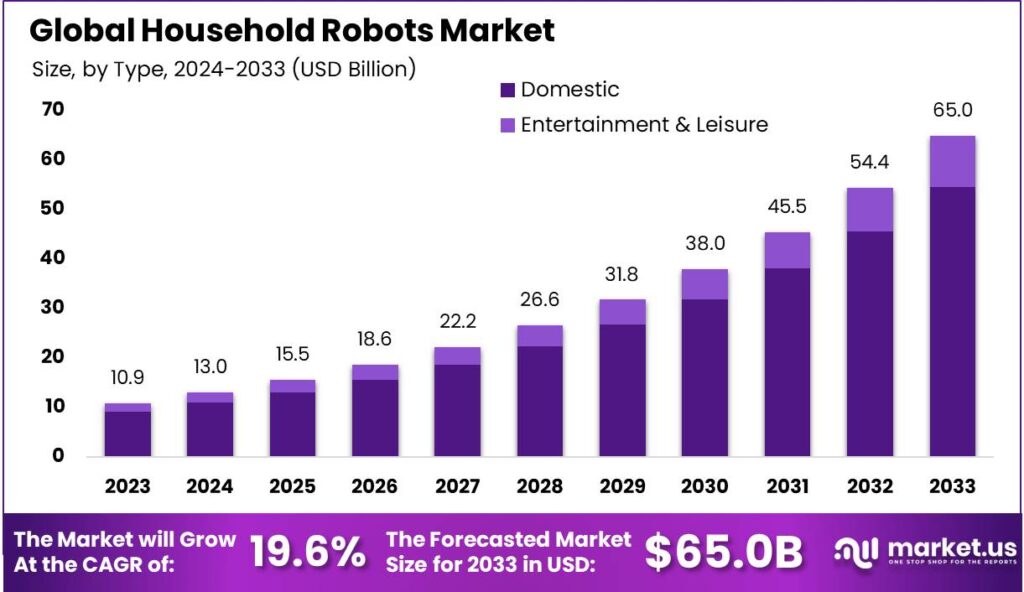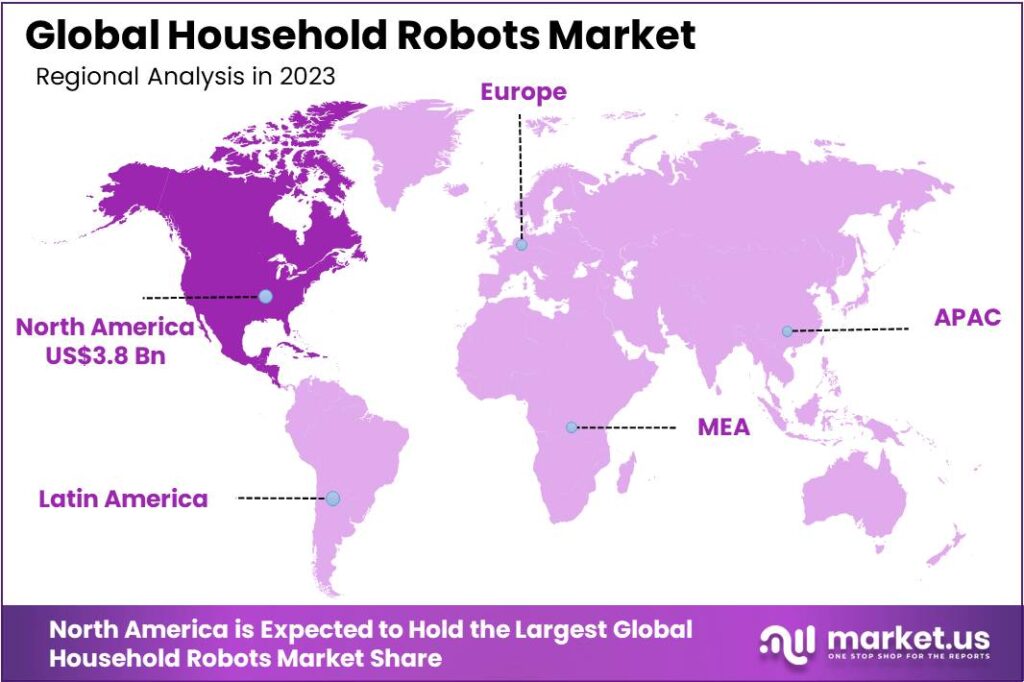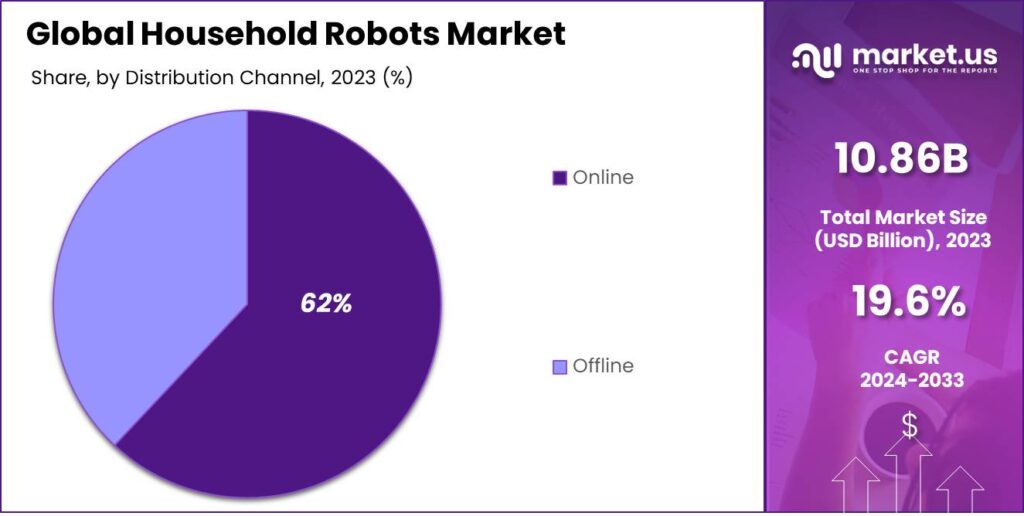Table of Contents
Report Overview
The Global Household Robots Market is poised for substantial growth, with projections indicating it will reach approximately USD 65.0 billion by 2033, up from USD 10.86 billion in 2023. This impressive expansion reflects a compound annual growth rate (CAGR) of 19.60% between 2024 and 2033. In 2023, North America led the market, capturing more than 35.3% of the share and generating a revenue of USD 3.8 billion.
Household robots are transforming the way we manage daily tasks, offering a seamless blend of convenience and efficiency within our homes. From vacuuming and mowing the lawn to providing companionship and aiding the elderly, these specialized devices are designed to handle a variety of domestic chores. As technology continues to evolve, these robots are becoming smarter, leveraging artificial intelligence to perform tasks autonomously or with minimal human input, making them an indispensable part of modern life.
The growth of household robots is driven by the increasing demand for convenience and time-saving solutions, as consumers look to streamline their routines. Advancements in AI and machine learning have made robots more autonomous and efficient, broadening their appeal. Additionally, the aging global population has fueled the need for assistance devices, further boosting the popularity of household robots.

Key applications of household robots are enhancing daily life across various domains. In cleaning, robots like vacuum cleaners and moppers save time and effort, especially for busy individuals or those with limited mobility. In elderly care, robots assist with health monitoring, medication management, and companionship. Additionally, robots in the kitchen help with cooking, meal prep, and dishwashing, automating repetitive tasks to free up time for more enjoyable or productive activities.
The household robot market faces several challenges despite strong growth prospects. High costs of advanced models limit accessibility, while the complexity of programming and maintenance can lead to user frustration and abandonment. Additionally, concerns over privacy and security, especially with robots featuring cameras and microphones, hinder widespread adoption.
Key trends in the household robot market include a shift toward multi-functionality. As consumers prioritize sustainability, manufacturers are creating robots that perform well while reducing their carbon footprint. The rise of remotely controlled robots via smartphones highlights a growing trend of increased user control and customization.The integration of voice recognition and AI enhances personalization, while a focus on sustainability drives the development of energy-efficient models.
Driven by a growing middle class in developing regions and increased access to advanced technologies, the household robots market is set for continued expansion. This growth will boost adoption in emerging economies. Additionally, the expansion of robotic capabilities in areas such as caregiving, cooking, and companionship offers new opportunities for market players.
Take advantage of our unbeatable offer - buy now!

Key Takeaways
- Products Segment: In 2023, the Products segment dominated the market, capturing over 80% of the market share.
- Domestic Segment: The Domestic segment led the market in 2023, commanding more than 84% of the total share of the Household Robots Market.
- Online Segment: The Online segment was the market leader in 2023, accounting for over 62% of the overall market share.
- Vacuuming & Mopping Segment: In 2023, the Vacuuming & Mopping segment held the largest share of the market, with more than 65% of the overall share.
- North America: North America held a dominant position in 2023, capturing over 35.3% of the market share and generating USD 3.8 billion in revenue.
Technological Innovations
- Improved AI for Task Recognition: Recent advancements in artificial intelligence (AI) have enhanced household robots’ ability to recognize and perform complex tasks. Robots are now able to understand the specific needs of a household by analyzing patterns in cleaning routines, preferred settings, and even human behavior. This improvement in AI allows robots to adapt to their environments and perform tasks more effectively.
- Advanced Navigation and Mapping Technology: Modern household robots use sophisticated mapping and navigation systems, such as LiDAR (Light Detection and Ranging) and visual cameras, to create detailed maps of their environment. These technologies help robots navigate around obstacles and clean every corner of the house without missing spots. As a result, the robots can move more autonomously and avoid potential hazards.
- Voice Command Integration: Voice assistants like Amazon Alexa, Google Assistant, and Apple Siri have been integrated into household robots, allowing users to control and manage tasks hands-free. This innovation makes it easier to operate robots, even while doing other tasks or when the user is far away from the device.
- Enhanced Battery Life and Charging Systems: Battery life has long been a limitation for household robots. However, with new innovations in battery technology and intelligent charging systems, robots now last longer and charge more efficiently. Some robots are even equipped with self-docking features, allowing them to return to their charging stations automatically when needed.
- Collaboration with Smart Home Devices: Household robots are increasingly being designed to work seamlessly with other smart home devices, such as thermostats, lighting systems, and security cameras. This integration enables users to control multiple devices through a single platform, enhancing the overall smart home experience.
Regional Analysis
In 2023, North America maintained a leading position in the global household robots market, commanding over 35.3% of the market share and generating a substantial USD 3.8 billion in revenue. This dominance can be attributed to several key factors, including the region’s advanced technological infrastructure, a high rate of consumer adoption of automation technologies, and the significant presence of major players in the robotics industry.
The strong consumer demand for automation solutions, driven by the growing interest in smart homes and the increasing desire for convenience, has played a crucial role in North America’s market leadership. Consumers are increasingly turning to household robots for tasks such as cleaning, security, and personal assistance, which has further fueled market expansion. Additionally, the high level of technological readiness and access to cutting-edge innovations has allowed North American consumers to quickly embrace new robotic solutions, positioning the region at the forefront of the market.
Moreover, North America benefits from the presence of key market players, such as iRobot, Dyson, and Ecovacs, who are actively shaping the household robotics landscape. These companies have been instrumental in pushing the boundaries of product development, introducing advanced features, and expanding their market reach, thus reinforcing North America’s dominant role in the sector.

Market Segmentation
Component Analysis
In 2023, the Products segment in the Household Robots Market maintained a dominant position, commanding over 80% of the total market share. This substantial share reflects the growing demand for autonomous robotic devices designed for household tasks. These products, such as robotic vacuum cleaners, mopping robots, and other smart appliances, are increasingly being integrated into homes due to their efficiency, time-saving features, and convenience. As technology continues to advance, these products are becoming more affordable and accessible, attracting a wider range of consumers. The substantial market share held by the Products segment signifies the strong adoption of household robots, driven by technological advancements, improved functionalities, and an increasing reliance on smart home solutions.
Type Analysis
In 2023, the Domestic segment also emerged as the leader within the Household Robots Market, capturing over 84% of the total market share. This dominance underscores the growing preference for robots that cater to everyday household chores, particularly those designed for residential use. Robots that automate cleaning, mopping, and vacuuming tasks are in high demand as they offer convenience and free up valuable time for consumers. The rising trend of urbanization, where busy professionals and families seek ways to reduce the time spent on household duties, has contributed to the expansion of the Domestic segment. Moreover, as consumer awareness and acceptance of robotic solutions have risen, the demand for domestic robots has surged.
Distribution Channel Analysis
The Online segment played a pivotal role in the sales of household robots in 2023, accounting for over 62% of the overall market share. E-commerce platforms have become the preferred channel for purchasing household robots due to the convenience of online shopping, detailed product reviews, and easy price comparisons. This surge in online sales is also fueled by the growth of global online retail giants, direct-to-consumer brands, and the increased comfort consumers have with purchasing high-tech products online. Additionally, online marketing and targeted advertising have helped raise awareness about the benefits of robotic products.

Application Analysis
In 2023, the Vacuuming & Mopping segment emerged as the leading category in the Household Robots Market, capturing more than 65% of the total market share. Robotic vacuum cleaners, which can autonomously clean floors, and robotic mops, designed to mop and scrub surfaces, have become incredibly popular. The widespread adoption of these devices can be attributed to their ability to save time, their ease of use, and their efficiency in maintaining clean homes with minimal human intervention. As these products continue to evolve with advanced sensors, AI-driven features, and multi-functional capabilities, they are likely to maintain their dominance in the market.
Top Use Cases
- Cleaning and Maintenance: Robotic vacuum cleaners and mops are evolving to offer more advanced navigation systems and stronger cleaning capabilities. These robots can remember their cleaning history to avoid repeated areas and focus on dirtier spots, making them more efficient. Additionally, window cleaning robots have improved to tackle more complex surfaces and reach difficult areas without human intervention.
- Home Security: Robots like Amazon’s Astro enhance home security by patrolling properties and providing real-time video feeds to homeowners, even when they are away. This ability to monitor homes remotely adds a layer of security and peace of mind, allowing users to check on their property from any location.
- Personal Assistance and Companionship: Robots equipped with advanced AI capabilities serve as personal assistants and companions, capable of managing daily tasks such as setting reminders, playing music, or even suggesting activities to lift moods. Their evolving interaction abilities make them increasingly humane and responsive to household members’ emotional states.
- Education and Child Engagement: Educational robots like ROYBI offer personalized learning experiences to children, supporting over 500 lessons in problem-solving and creative thinking. These robots are designed to engage children in educational activities while providing feedback on their progress, which supports both academic and emotional development.
- Kitchen Assistance: Robot chefs are a burgeoning innovation in household robotics, capable of preparing meals from start to finish. These robots can manage various cooking tasks, from chopping and sautéing to baking, using preset recipes and adjusting techniques based on the ingredients’ freshness. This technology not only helps those with busy schedules but also assists those looking to improve their cooking skills with precision and consistency.
Major Challenges
- Technical Complexity: Designing robots capable of performing diverse household tasks is intricate. Even simple actions, like opening a door, involve numerous variables such as handle types and unforeseen obstacles, making programming for all scenarios difficult.
- High Costs: The development and production of advanced household robots require substantial investment, resulting in high prices that are prohibitive for many consumers. Early models can cost thousands of dollars, limiting their accessibility.
- Safety Concerns: Integrating robots into homes raises safety issues, especially when they operate in close proximity to humans. Ensuring that robots can navigate and perform tasks without causing harm is a significant hurdle.
- Privacy and Security Risks: Household robots equipped with cameras and sensors may collect personal data, leading to privacy concerns. Additionally, vulnerabilities in their systems could be exploited, posing security threats.
- Limited Functionality: Current household robots often perform specific tasks, such as vacuuming, but lack the versatility to handle multiple chores. Developing robots with broader capabilities remains a complex challenge.
Competitive Landscape
- iRobot Corporation stands out as a leader in the household robotics industry, primarily known for its Roomba vacuum cleaning robots. As an innovator in the field, iRobot has consistently focused on enhancing the usability and effectiveness of its products through advanced technology. The company’s commitment to developing robots that can seamlessly integrate into everyday life has helped solidify its position at the forefront of the market.
- Neato Robotics Inc. is renowned for its innovative approach to robot vacuum design, particularly its D-shaped robots that are optimized for cleaning corners more effectively than traditional round models. Neato’s use of laser-guided navigation systems allows its robots to map and navigate homes with precision, ensuring thorough coverage. The company has carved a niche for itself by offering robots that are not only smart but also capable of adapting to the diverse and changing layouts of modern homes.
- Samsung Electronics Co. Ltd has expanded into household robots, integrating them with its existing smart home products for a seamless experience. Leveraging its global presence and advanced technology, the company offers sophisticated yet accessible robots, aiming to lead in the growing smart home market.
- Ecovacs Robotics Inc. is known for its DEEBOT series of vacuum cleaners, which combine robust cleaning capabilities with innovative features such as voice and app control. The company focuses on providing a high degree of customization in its products, allowing users to choose cleaning modes and schedules that best fit their lifestyle. Ecovacs is known for creating user-friendly and adaptable robotic cleaners, appealing to consumers who value flexibility and control in their home cleaning devices.
- Panasonic Corporation, a longstanding giant in consumer electronics, has ventured successfully into household robotics with products designed to enhance home security and maintenance. Panasonic’s robots are distinguished by their durability and the integration of advanced technology, such as artificial intelligence and obstacle detection sensors. This makes them reliable and effective in various household tasks beyond just cleaning, like monitoring for security purposes.
Market Opportunities for Key Players
- Advanced Cleaning Solutions: There is a continued demand for robotic vacuum and mopping systems, which are becoming more sophisticated with features like automated dirt disposal and advanced navigation technologies. Companies like Roborock and iRobot are leading the way with their innovative product offerings.
- Elderly and Handicap Assistance: Robots designed to assist the elderly and individuals with disabilities represent a growing segment. These robots can perform tasks ranging from basic companionship to more complex care functions, which can help alleviate the strain on human caregivers and improve the quality of life for this demographic.
- Integration with Smart Home Systems: As smart homes become more prevalent, there is a significant opportunity for household robots that can seamlessly integrate with other smart home technologies. This integration allows for more cohesive and user-friendly home automation, where robots can communicate with other devices to perform tasks more efficiently.
- Diverse Applications Beyond Vacuuming: Expanding the functionality of household robots beyond traditional cleaning to include options like lawn mowing, pool cleaning, and even window washing can cater to a broader market. Companies are exploring these areas to diversify their product lines and enhance the utility of household robots.
- Geographic Expansion: Emerging markets represent a significant opportunity for household robotics companies. These regions are witnessing rapid urbanization and increasing disposable incomes, making them ripe for the adoption of robotic technologies. Tailoring products to meet the specific needs and preferences of these diverse markets can lead to substantial growth.
Recent Developments
- In January 2024, ECOVACS unveiled the next frontier in home robotics, introducing a suite of cutting-edge solutions designed to revolutionize household care. These advanced robots seamlessly cover every aspect of home maintenance, from floor cleaning and air purification to ceiling, window, and lawn care.
- In August 2024, 1X, a trailblazer in humanoid robotics, introduced NEO Beta—a groundbreaking prototype of its bipedal humanoid robot designed specifically for home use. Combining advanced robotics with sleek design, NEO Beta promises to enhance everyday life with its versatile capabilities, offering a glimpse into the future of household automation. With its launch, 1X is paving the way for smarter, more interactive homes.
Conclusion
In summary, the household robots market has experienced significant growth in recent years, driven by advancements in artificial intelligence, robotics, and automation technologies. The increasing demand for convenience, improved quality of life, and time-saving solutions has accelerated the adoption of robots for tasks such as cleaning, security, and elderly care. The growing interest in smart homes, coupled with the rise of consumer interest in robotic assistants, is expected to propel the market even further in the coming years.
However, challenges such as high initial costs, limited battery life, and technological barriers remain, which could affect the widespread adoption of household robots. Despite these obstacles, ongoing research and development efforts, along with increased consumer awareness and acceptance, suggest a promising future for the market. As robots become more affordable and capable, they are poised to revolutionize home management and everyday tasks, making them an integral part of future households.
Discuss your needs with our analyst
Please share your requirements with more details so our analyst can check if they can solve your problem(s)



